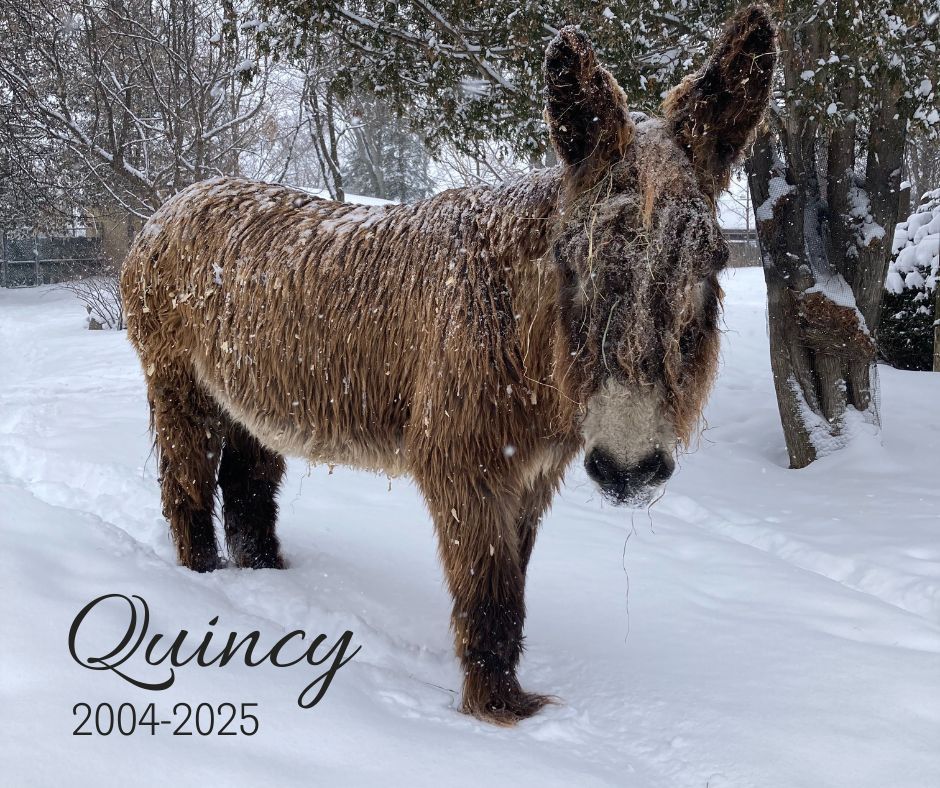- The life and health challenges of Quincy, a baudet du Poitou, and the specifics of equine metabolic syndrome.
- The management practices and veterinary care employed at the zoo to support Quincy’s well-being.
- The ethical considerations involved in wildlife management and animal welfare in captivity.
- Community support and the role it plays in zoo operations and conservation efforts.
- Insights into enhancing animal welfare and conservation through scientific research and public engagement.
Quincy, our beloved baudet du Poitou, recently passed away, highlighting the poignant realities of managing the health and well-being of animals in captivity. Quincy arrived at the zoo in 2015, already displaying symptoms of equine metabolic syndrome (EMS), a chronic condition known to affect horses and donkeys. EMS is characterized by obesity, insulin resistance, and intermittent episodes of laminitis, a painful and debilitating hoof condition. This article aims to explore Quincy’s life, the healthcare interventions used, the role of the community, and the broader implications for animal welfare and conservation.
Quincy was emblematic of her breed, the baudet du Poitou, which is famed for its distinctive appearance and historical significance. However, she also faced the complex health challenges associated with her breed. Equine metabolic syndrome manifesting in Quincy resulted in numerous bouts of laminitis, generating significant discomfort and pain. This scenario is not uncommon in older equines who, due to genetic predisposition and other factors, develop EMS.
The veterinary team at the zoo attempted several interventions to alleviate her suffering. Rigorous management strategies were implemented, encompassing dietary adjustments, exercise protocols, and specially designed footwear aimed at reducing discomfort and preventing further hoof deterioration. Anti-inflammatory medications and analgesics were administered to manage pain. These treatments, while comprehensive, unfortunately, did not offset the progressive nature of her condition. Quincy’s quality of life continued to diminish despite the focused care efforts.
This situation underscores the imperative of advancing veterinary practices and zoo management strategies. There is a continual need for research into new treatment modalities that could offer improved outcomes for animals like Quincy suffering from chronic conditions. Additionally, the zoo’s experience with Quincy emphasizes the importance of early diagnosis and intervention, possibly incorporating metabolic monitoring and genetic assessments for at-risk species.
The decision to euthanize is one of the most challenging aspects of animal management in zoos. It involves a careful consideration of the animal’s quality of life, the irreversibility of their medical condition, and the suffering sustained daily. Quincy’s case serves as a reminder of the ethical responsibilities tasked to zoos and veterinarians to prioritize animal welfare and make humane choices in dire situations.
The support from the community during times of loss plays a crucial role in zoo operations and conservation initiatives. Zoos are often seen not only as places of education and entertainment but also as the custodians of endangered species and the advocates for wildlife conservation. Community engagement is fundamental, be it through volunteer programs, educational outreach, or conservation fundraising. This communal involvement sustains the zoo’s mission and its efforts to provide optimal care to its residents and contribute to the global conversation on wildlife protection.
Animal welfare extends beyond immediate care. Scientific research and collaboration within the zoological community are essential components for advancing conservation efforts. There is a need to continually refine strategies to enhance habitat design, nutrition, and breeding programs to better mimic natural conditions and support the physical and psychological health of captive animals.
Engaging the public through educational programs helps foster a deeper understanding of environmental stewardship. Highlighting the challenges faced by animals such as Quincy provides a tangible context for discussions about conservation, biodiversity, and the human impact on wildlife habitats. This knowledge empowers individuals and communities to make informed decisions supporting conservation efforts globally.
Quincy’s departure is a stark reminder of the both rewarding and heart-wrenching aspects of zoo management. Her story prompts critical reflection on improving care for animals with complex health challenges. An unwavering dedication to scientific research, ethical animal welfare practices, and community involvement remains key to advancing our efforts in protecting and preserving animal species for future generations.
*****
Source Description
🌹 C’est avec tristesse que nous partageons avec vous le décès de la belle Quincy, notre baudet du Poitou.
Arrivée au Zoo en 2015, Quincy (20 ans) démontrait déjà des signes du syndrome métabolique équin, qui s’est soldé par de nombreuses crises de fourbure au fil du temps. Ceci générait chez l’animal de plus en plus d’inconfort et de douleur: on doit malheureusement se rendre à l’évidence que Quincy avait tiré le mauvais numéro en terme de santé.
Malgré un suivi vétérinaire serré, des traitements adaptés contre la douleur et même le port de bottes spécialisées, l’équipe d’experts médicaux n’a pu que constater que la situation de la femelle était irréversible et que les traitements ne parvenaient plus à la soulager: sa qualité de vie étant affectée, elle a pris la décision de la libérer de ses souffrances.
Perdre un animal sous nos soins n’est jamais facile; nous savons que nous pouvons compter sur le soutien de notre communauté durant cette période difficile.🌹


